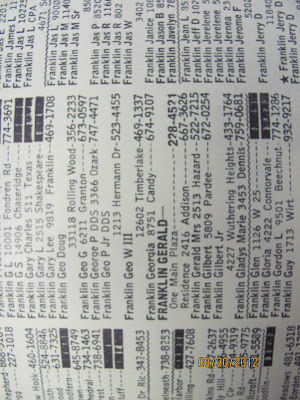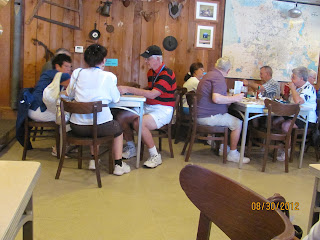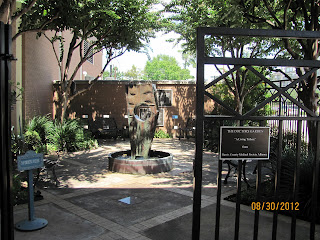We went to lunch at Hickory Hollow bar-b-q on Heights Blvd. and Washington Avenue.
After lunch we had time to spare so our bus driver drove around some and then he took us down for a mini tour of the Houston Archival Library and we were able to go in and see the renovation and tour it on our own. It was very beautiful and full of architecture. It holds the largest amount of Architecture information in the United States.
We then went on to the McGovern health and science building. We were able to tour it and lot a lot about our bodies and minds. We were able to take in a 4 D movie and then we were back on our bus to come home.
It was a very nice trip and we enjoyed it very much. we really do appreciate all our 4 couples do, to bring us such great trips and places to see. Not to mention the places they find for us to eat.
Here is a copy of an article that was in the Houston Chronicle this week.
Hello, Central, here's a story of way-back times. Long ago, in the days of wire-based communication, before the cellphone or even the rotary dial, there was the operator. With granite composure and nimble fingers, the switchboard queen calmed emergencies and reunited the long-separated.
For almost 50 years, the operator and her analog world have been celebrated at Houston's telephone museum, a quirky collection of granny-era technology surprising in its ingenuity.
Now, though, the Doc Porter Museum of Telephone History, Houston's switchboard connection to its telephonic past, is going dark. AT&T is selling its building.
"They've told me there's no provision for us," said museum curator Oleta Porter, widow of longtime telephone company employee, Clyde "Doc" Porter, for whom the museum is named. "I expect we'll have to be out by the end of the year."
Real estate agent Michael Hassler said completion of the sale of the building at 1714 Ashland is imminent. The telephone museum, which has occupied various AT&T buildings since its founding in 1966, has filled much of the Houston Heights building's second floor since 1996.
Also affected by the sale are workrooms where volunteers sew "Hug A Bears" for children in traumatic situations and repair audiobook players used by the blind.
The charitable activities and the museum are operated by Telecom Pioneers, an association of retired telecommunications workers.
Relocation challenges
Porter, whose late husband is credited with expanding the museum to its present scope, said she will continue to search for a suitable venue for display of the thousands of artifacts.
South Texas Pioneers President Deberah Joseph, though, said an agreement has been reached with AT&T, which owns many of the objects, to place the collection in storage. Some of the artifacts, which range from wire splicers to switchboards, could be displayed at AT&T buildings, she said.
Alice Aanstoos, the company's regional vice president for external affairs, said only that AT&T is "negotiating" with the Pioneers, and hopes to help resolve the question of what to do with the collection.
Major challenges in relocating the museum exhibits to another local venue are the collection's size - it currently fills almost 7,500 square feet - and the fact that any new location must come, essentially, free. AT&T historically has provided museum space free and paid the electric bill. Joseph said company officials would have to approve a move of AT&T-owned artifacts to a third-party location.
The telephone museum is among the small, volunteer-operated museums that spring up in Houston's residential neighborhoods.
An average 600 people annually tour the museum, which is open to walk-in visitors only on Tuesdays.
On display are switchboards, including a Braille model, and photos of the intrepid women at work. The operator's role as intervenor in completing every call began to wane with the introduction of dial-it-yourself rotary phones in 1919. Telephones with punch-button dials made their appearance on a large scale in the 1960s.
Fashionable phones
The museum's 1876 telephone - Alexander Bell's first - is only a replica, but the exhibit cases are filled with hundreds of genuine phones ranging from the most primitive to iconic Mickey Mouse models.
Augmenting the museum's assemblage of "candlestick" phones is a temporary exhibit of telephone vanities, high-style cabinets that concealed the telephones' inner works for placement in fashionable settings. Among them are early pay phones equipped to accept silver dollars. Visitors embracing the contemporary vogue of telephone conversations as public performance, may be surprised by early 20th-century pay phone booths, double-walled to keep conversations in and outside noises out.
The museum's collections abruptly stop in the mid-1980s with the advent of commercial mobile phones.
"There are no cellphones," Porter said, "We wanted to keep things in the era of wire."
allan.turner@chron.com
This is off a door that was in San Antonio Texas.
Oleta Porter discussing the telephone museum
An old operators swithch board they had to use.
An old wooden Bell .
Not so long ago...
This is what they used to count the monies from the pay phones.
More old phones
I found our name in this old phone book that operators used when someone called dlooking for a phone number.
I remember useing one like this when I was very young.
These lights were used to help you locate a phone at night.
The first picture phone.
Different fuses used.
many old phones fron the 1920's
Old Wall phones.
Old Signs.
Nice display of phone equipment.
Very old antique phones.
other items that were manufactured by Western Electric Co. during the war. A fan.
Sewing machines.
Time for Lunch...
They had tables reserved for us..
Art work in Houston Texas.
An old home in the 6th ward part of Houston.
Schulpers in Houston Texas.2012
Houston Library.
Leather clad doors.
Wall mural painting.
Just resting I guess.
Old Water well.
Inside
photo equip.
Nice fountain downtown Houston Texas 2012
Medical Science Mesume
Another resting spot.
Go in and check out his teeth.

























































No comments:
Post a Comment